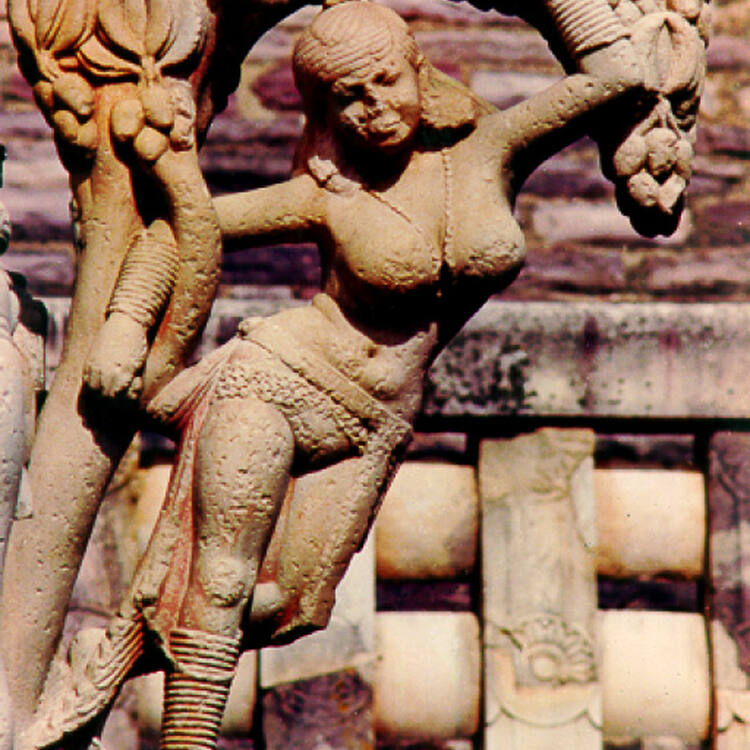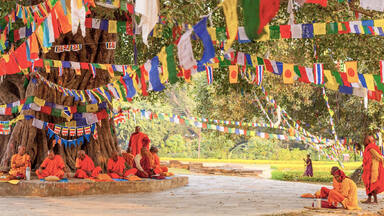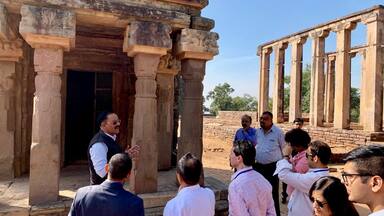Buddhist Monuments at Sanchi
Buddhist Monuments at Sanchi
On a hill overlooking the plain and about 40 km from Bhopal, the site of Sanchi comprises a group of Buddhist monuments (monolithic pillars, palaces, temples and monasteries) all in different states of conservation most of which date back to the 2nd and 1st centuries B.C. It is the oldest Buddhist sanctuary in existence and was a major Buddhist centre in India until the 12th century A.D.
Description is available under license CC-BY-SA IGO 3.0
Monuments bouddhiques de Sânchî
Sur une colline dominant la plaine, à une quarantaine de kilomètres de Bhopal, le site de Sânchî regroupe des monuments bouddhiques (piliers monolithes, palais, temples et monastères), inégalement conservés, remontant pour l'essentiel aux Ier et IIe siècle av. J.-C. C'est le plus ancien sanctuaire bouddhique existant et il est resté un centre essentiel du bouddhisme en Inde jusqu'au XIIe siècle.
Description is available under license CC-BY-SA IGO 3.0
نصب سانشي البوذية
يضمّ موقع سانشي الذي يتربّع على تلة تطلّ على السهل على بُعد حوالي أربعين كيلومتراً من بوبال نصباً بوذية (دعائم أُحادية الحجر، وقصور، ومعابد، وأديرة) تمّ الحفاظ عليها بصورة متفاوتة، عائدة بمعظمها للقرنين الأول والثاني قبل الميلاد. إنّ هذا الموقع هو أقدم معبد بوذي موجود، وقد بقي مركزاً أساسياً للبوذية في الهند حتى القرن الثاني عشر.
source: UNESCO/CPE
Description is available under license CC-BY-SA IGO 3.0
桑吉佛教古迹
桑吉佛教建筑群距离博帕尔约40公里,坐落在小山上,俯瞰着平原。古迹由一组佛教建筑群构成,包括巨石石柱、宫殿、庙宇和寺院。这些建筑的历史大多可追溯到公元前2世纪至公元前1世纪,它们都不同程度地保存了下来。在12世纪前这里一直是印度佛教的教理中心,目前它是现存最古老的佛教圣地。
source: UNESCO/CPE
Description is available under license CC-BY-SA IGO 3.0
Буддийские памятники в Санчи
Комплекс Санчи расположен на холме, окруженном равнинами, приблизительно в 40 км от города Бхопал. Он состоит из группы буддийских памятников (монолитных столпов, дворцов, храмов и монастырей), которые имеют различную степень сохранности и в основном относятся к II-I вв. до н.э. Это самое древнее из сохранившихся буддийских святилищ, являвшееся основным центром буддизма в Индии вплоть до XII в.
source: UNESCO/CPE
Description is available under license CC-BY-SA IGO 3.0
Monumentos budistas de Sanchi
Alzado en lo alto de una colina que domina la llanura, a unos cuarenta kilómetros de Bhopal, el sitio de Sanchi comprende diversos monumentos budistas –pilares monolíticos, palacios, templos y monasterios– en un estado de conservación desigual, que datan esencialmente de los siglos I y II a. C. Es el santuario del budismo más antiguo de todos los existentes y fue el centro principal de esta religión en la India hasta el siglo XII.
source: UNESCO/CPE
Description is available under license CC-BY-SA IGO 3.0
サーンチーの仏教建造物群
source: NFUAJ
Boeddhistische monumenten van Sanchi
Source: unesco.nl
सांची के बौद्ध स्मारक
भोपाल से लगभग 40 किमी दूर मैदान जैसे दिखने वाली एक पहाड़ी पर बौद्ध स्मारकों (अखंड स्तंभों, महलों, मंदिरों और मठों) से समृद्ध सांची स्थित है। ये स्मारक संरक्षण की विभिन्न अवस्थाओं में हैं। इनमें से अधिकांश दूसरी और पहली शताब्दी ईसा पूर्व के हैं। आज भी दर्शनीय यह सबसे पुराना बौद्ध स्थल है, जो 12वीं सदी तक भारत में एक प्रमुख बौद्ध केंद्र रहा था।
Source: India
Outstanding Universal Value
Brief synthesis
The stupas, temples, viharas, and stambha at Sanchi in central India are among the oldest and most mature examples of aniconic arts and free-standing architecture that comprehensively document the history of Buddhism from the 3rd century BCE to the 12th century CE. About 10 km from Vidisha, the Buddhist monuments at Sanchi, located on a serene and picturesque forested plateau, are also considered to be the sacrosanct Cetiyagiri in the Sri Lankan Buddhist chronicles, where Mahindra, the son of Emperor Aśoka, stopped prior to undertaking his journey as a missionary to Sri Lanka. The enshrined remains of Sariputra and Maudgalyayana (chief disciples of Buddha) in Sanchi were venerated by Theravadins, and continue to be revered to the present day.
The inception of Sanchi as a sacred centre is attributed to the Mauryan emperor Aśoka. His reign in the 3rd century BCE is considered instrumental to the spread of Buddhism throughout the Indian subcontinent. With the establishment of the monolithic Aśoka Stambha (pillar) bearing a highly elaborate capital, Emperor Aśoka distinguished Sanchi as a site of great importance. Contemporary with the stambha was a brick stupa, which was later increased in scale during the Sunga dynasty (184-72 BCE), covered with an ashlar stone veneer, and augmented with circumambulatory paths and staircases with ornate balustrades, harmika, yashti, chhatra, and four torana, which were later ornamented during the Satavahanas dynasty in the 1st century CE. The last addition to the grand stupa was during the Gupta dynasty (5th century CE), when four shrines were added at the cardinal entry points. Today, this grand structure of Sanchi (“Stupa 1”) is considered an incomparable example of the mature phase of Indian stupas. Since Aśokan times, subsequent powerful empires that reigned over this region – such as the Sunga, Kushana, Kshatrapa, and finally Gupta dynasties – continued to contribute to the expansion of Sanchi with the construction of hypostyle, apsidal, and other temples and shrines, comparatively smaller stupas (Stupas 2 and 3), and numerous viharas. Corroborated by inscriptions present in the property, Sanchi remained an important seat of Buddhism until the 13th century CE.
The Buddhist monuments at Sanchi contain an appreciable concentration of early Indian artistic techniques and Buddhist art, referred to as its Anionic School or Phase. Depicting Buddha through symbols, the sculpted art shows the evolution in sculpting techniques and the elaboration of icons, especially depicting Buddha. Stories and facts of great religious and historical significance, enlivened with bas-relief and high-relief techniques, are also depicted. The quality of craftsmanship in representing the gamut of symbolism through plants, animals, human beings, and Jataka stories shows the development of art though the integration of indigenous and non-indigenous sculpting traditions.
Criterion (i): The perfection of its proportions and the richness of the sculpted decorative work on its four gateways make Stupa 1 an incomparable artistic achievement. The group of Buddhist monuments at Sanchi – stupas, temples and monasteries – is unique in India because of its age and quality.
Criterion (ii): From the time that the oldest preserved monument on the site was erected, i.e., Aśoka’s column with its projecting capital of lions inspired by Achaemenid art, Sanchi’s role as intermediary for the spread of cultures and their peripheral arts throughout the Mauryan Empire, and later in India of the Sunga, Shatavahana, Kushan and Gupta dynasties, was confirmed.
Criterion (iii): Having remained a principal centre of Buddhism up to early medieval India following the spread of Hinduism, Sanchi bears unique witness as a major Buddhist sanctuary in the period from the 3rd century BCE to the 1st century CE.
Criterion (iv): The stupas at Sanchi, in particular Stupa 1 and Stupa 3, represent the most accomplished form of this type of monument. The hemispherical, egg-shaped dome (anda), topped with a cubical relic chamber (harmika), is built on a circular terrace (medhi); it has one or two ambulatories for the faithful to use (pradakshina patha). Representing a transition from wood structures to stone, the railings (vedika) and the gateways (torana) also bear witness to the continued use of the primitive forms of megalithic tumuli covered with an outer layer and surrounded by a palisade.
Criterion (vi): Sanchi is one of the oldest extant Buddhist sanctuaries. Although Buddha never visited the site during any of his former lives or during his earthly existence, the religious nature of this shrine is obvious. The chamber of relics of Stupa 3 contained the remains of Sariputra, a disciple of Shakyamuni who died six months before his master; he is especially venerated by the occupants of the “small vehicle” or Hinayana.
Integrity
Within the boundaries of the property are all the known elements necessary to express its Outstanding Universal Value, including the sculpted monolithic pillars, sanctuaries, temples, and viharas atop and along the slopes of the hillock of Sanchi. These elements demonstrate the complete vocabulary of mature Buddhist aniconic art and free-standing architecture. The property, which also encompasses its near natural setting, is thus of adequate size to ensure the complete representation of the features and processes that convey the significance of the Buddhist Monuments at Sanchi. The property is in a good state of conservation. Threats and potential threats to the integrity of the property include pressure from the local villagers to use the right-of-way in the prohibited area (as was the case in the historic past), incursions into this area, and development in the villages.
Authenticity
The archaeological remains of the Buddhist Monuments at Sanchi are authentic in terms of their locations and setting, forms and design, and materials and substance, as well as, to a degree, their spirit. These representations of mature Buddhist free-standing architecture and aniconic sculpted art remain at their original locations and in a setting that is sympathetic. The Sanchi stupas (numbered 1, 2, and 3) were restored in the early 20th century and demonstrate all the original features characteristic of mature Indian stupas. Though abandoned for about 600 years, Sanchi has witnessed the revival of a pilgrimage from all over the Buddhist world, and in particular from Sri Lanka, thus testifying to the religious significance of this place. The site is alive with chants and prayers to immortalize the remains of Sariputra and Maudgalyayana, two of the foremost disciples of Lord Buddha.
Protection and management requirements
The property is owned by the Government of India and is conserved, protected, maintained, and managed by the Archaeological Survey of India under the Ancient Monuments and Archaeological Sites and Remains (AMASR) Act (1958) and its Rules (1959), and Amendment and Validation Act (2010). The rural landscape surrounding the property is managed by the Nagar panchayat (municipality) and is governed by the Madhya Pradesh Bhumi Vikas Rules (1984), which can regulate and protect heritage sites. In addition, Clause 17 of Section 49 of the Madhya Pradesh Panchayati Rajya Adhiniyam (1993) provides additional support in heritage protection. Governed by the aforementioned legislative instruments, including the AMASR Act 2010, the Sanchi vikas Yojna Praroop (2001) and a plan under Nagar tatha gram nivesh Adhiniyam (1971), prepared by the Madhya Pradesh Town and Rural Planning Department, Bhopal, are being implemented to manage areas beyond the protected and prohibited area.
Conducting regular monitoring exercises, especially assessments of the state of conservation before and after the peak season, remains a long-term goal to ensure protection of the attributes that sustain the Outstanding Universal Value of the property. Assessment of issues in the protected area, including development in the villages, and dissemination of information remain long-term management needs.


